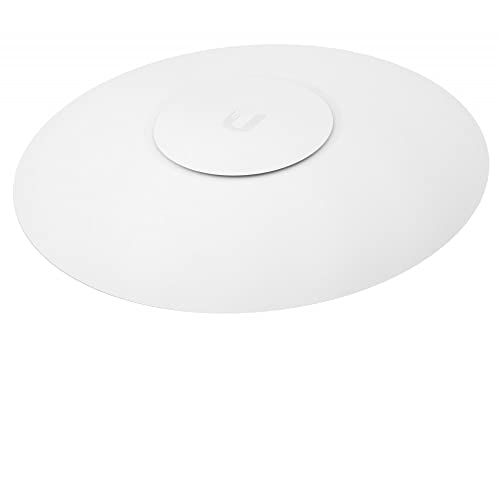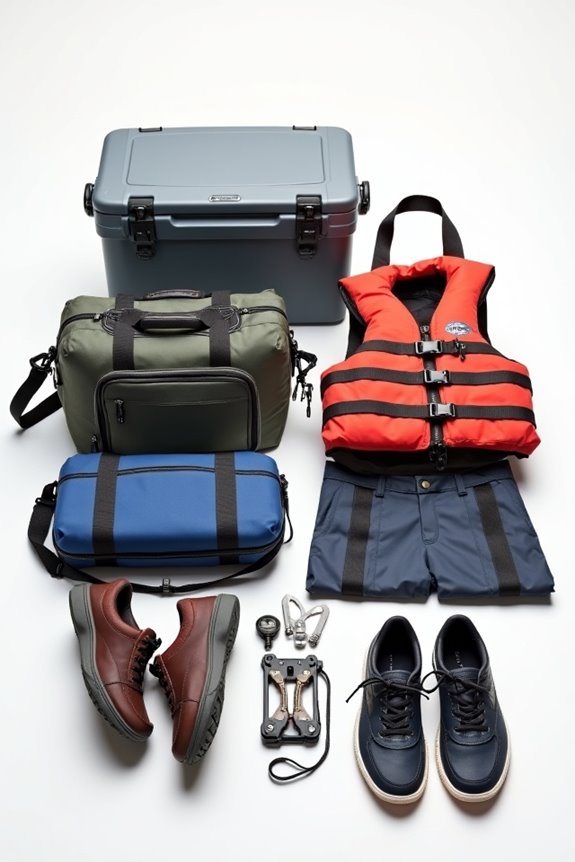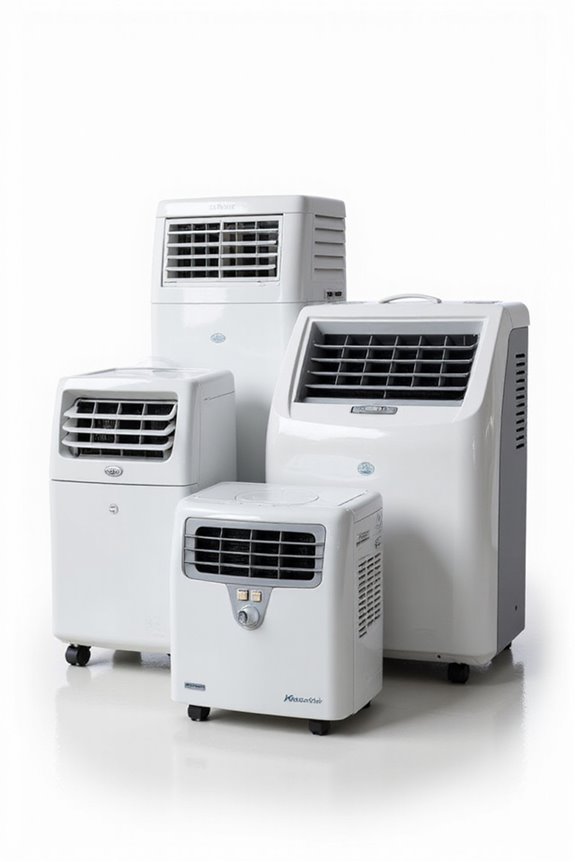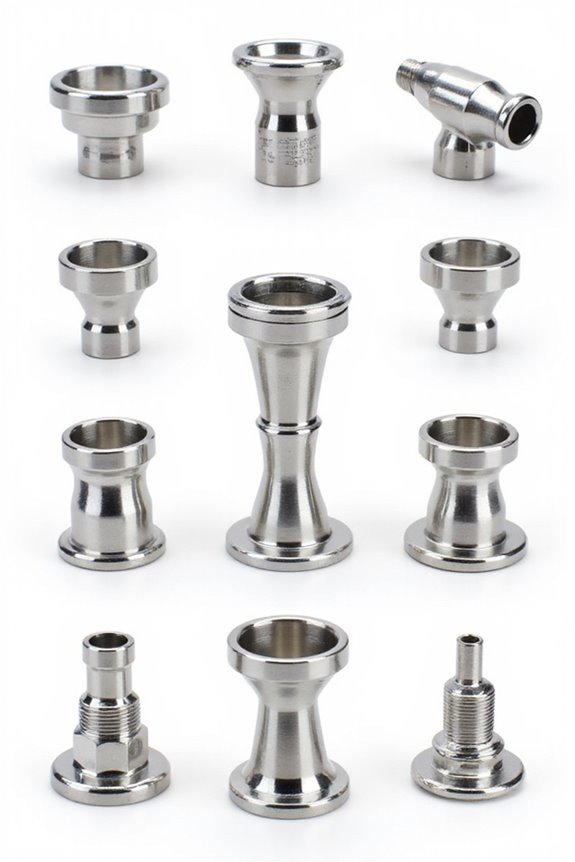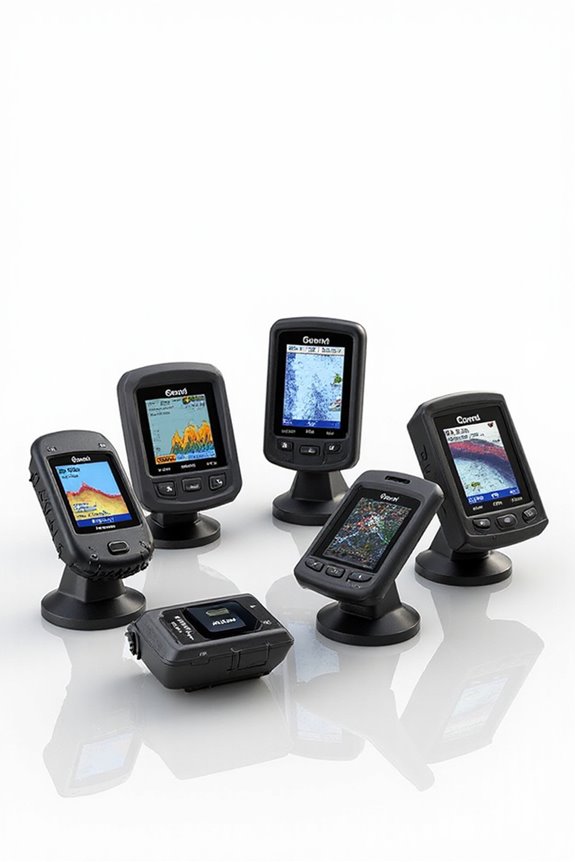As an Amazon Associate, we earn from qualifying purchases. Some links may be affiliate links at no extra cost to you. Although our opinions are based on curated research, we haven't used these products. Articles generated with AI.
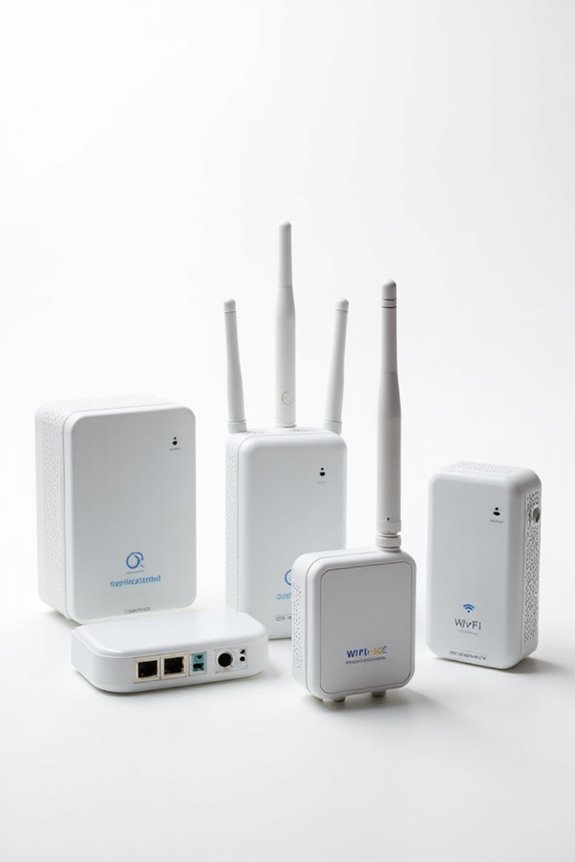
5 Best Marine WiFi Access Points for Reliable Connectivity at Sea
If you’re looking to stay connected at sea, consider these five great marine WiFi access points: NETGEAR’s WAX615 offers blazing speeds and solid coverage, while EnGenius’ EWS356-FIT is perfect for tough marine conditions. The compact WAX210PA provides reliable performance, and TP-Link’s TL-WA1201 excels in streaming. Finally, Ubiquiti’s UAP-AC-PRO-US delivers excellent network management features. So, why not guarantee smooth sailing with one of these? Stick around, and we’ll help you choose the best fit!
Key Takeaways
- Look for WiFi 6 access points like the NETGEAR WAX615 or EnGenius Fit EWS356-FIT for high-speed connectivity and support for multiple devices at sea.
- Ensure access points have strong coverage; models like the NETGEAR WAX615 cover up to 3,000 sq. ft., ideal for larger vessels.
- Consider Power over Ethernet (PoE) compatibility for easier installation without needing multiple outlet connections.
- Choose models with robust security features, including WPA3 encryption and multiple SSIDs to separate guest and crew networks.
- Opt for devices with good thermal management, as overheating can be an issue in marine environments, particularly for the EnGenius Fit EWS356-FIT.
NETGEAR Cloud Managed Wireless Access Point (WAX615)
NETGEAR Cloud Managed Wireless Access Point (WAX615) - WiFi 6 Dual-Band AX3000 Speed | Up to 256...
- Ultrafast 7.8Gbps total tri-band WiFi speed, including a new 6GHz band with more speed and capacity for the latest high-performance WiFi 6E devices.
- Supports up to 456 client devices and 3,000 sq. ft. of coverage.
- Enterprise-level security with up to 8 SSIDs, WPA3 security, and VLAN network and client isolation.
If you’re on the hunt for a reliable WiFi solution that can handle the demands of your marine adventures, seek no more than the NETGEAR Cloud Managed Wireless Access Point (WAX615). This WiFi 6 dual-band powerhouse boasts speeds up to 7.8Gbps and can connect up to 456 devices—perfect for when everyone’s streaming their favorite shows. With a range of 3,000 sq. ft., you’ll enjoy solid coverage aboard. Plus, the easy installation and management through the NETGEAR Insight app keep things simple. Just think: no more arguments about who gets to use the WiFi first. Sounds like a win to me!
Best For: Users in large homes or offices seeking a high-performance WiFi solution that can connect multiple devices efficiently.
Pros:
- Up to 7.8Gbps total tri-band speed with WiFi 6 technology for high-performance device connectivity.
- Supports up to 456 client devices, making it ideal for environments with heavy internet usage.
- Easy installation and remote management via the NETGEAR Insight app for simplified deployment.
Cons:
- Initial performance issues reported by some users related to power supply and configuration.
- Mixed reviews on customer support quality, which may affect troubleshooting experiences.
- Optional AC adapter not included, potentially necessitating additional purchases for some users.
EnGenius Fit Wireless Access Point (EWS356-FIT)
EnGenius Wi-Fi 6 [EWS356-FIT] Dual Band AX3000 | Cloud & App & OnPrem Control Options | WPA3,...
- 【True Wi-Fi 6 Dual-band】Unlock the full potential of Wi-Fi 6 with our superior dual-band solution, enabling seamless operation of both 2.4G and 5G radios at WiFi 6...
- 【Dual Concurrent Architecture】2x2 antenna with dual concurrent 802.11ax architecture, providing backward compatibility with 11ac/a/b/g/n client devices and supporting...
- 【Network Management Flexibility】Choose between cloud or on-premises management options based on your network architecture and administrative permissions.
The EnGenius Fit Wireless Access Point (EWS356-FIT) shines as an excellent choice for marine environments, specifically designed to deliver robust connectivity even in challenging conditions. With its Wi-Fi 6 dual-band capabilities, you’ll experience speeds up to 1,200 Mbps on 5 GHz and 574 Mbps on 2.4 GHz—perfect for streaming your favorite shows while you’re at sea. Plus, its cloud-based management lets you control your network from anywhere. Just keep in mind, you’ll need an Ethernet connection and an external power adapter for setup. Who knew marine Wi-Fi could be this simple? That’s smooth sailing!
Best For: The EnGenius Fit Wireless Access Point (EWS356-FIT) is best for users seeking reliable Wi-Fi connectivity in marine environments or locations where robust network performance is essential.
Pros:
- Cloud-based management for remote network control.
- High speeds up to 1,200 Mbps on the 5 GHz band for smooth streaming.
- Effective signal coverage ideal for homes and small businesses.
Cons:
- Requires an Ethernet connection and external power adapter for setup (not included).
- Installation may present challenges, especially with mounting.
- Concerns about overheating in high-temperature environments.
NETGEAR Wireless Access Point (WAX210PA) – WiFi 6 Dual-Band AX1800
NETGEAR Wireless Access Point (WAX210PA) - WiFi 6 Dual-Band AX1800 Speed | 1 x 1G Ethernet PoE Port...
- Its compact size makes it ideal for a retail store, business lobby, or any location where you want a less noticeable yet powerful, dedicated and secure WiFi network.
- Dual-Band AX1800 speed and capacity, coupled with MU-MIMO technology, supports up to 128 client devices.
- Simplified deployment with PoE, or power using the included PAV12V25-10000S power adapter.
Looking for a reliable wireless access point that won’t let you down? The NETGEAR Wireless Access Point (WAX210PA) offers WiFi 6 dual-band performance with speeds up to AX1800. It supports up to 128 devices—perfect for busy boats or gatherings at sea! With its compact design, you can mount it almost anywhere. Plus, with Power over Ethernet, setup’s a breeze. The MU-MIMO technology helps multiple devices communicate at once, so you won’t have to put your phone on a diet while streaming. It’s got a solid rating and user-friendly installation, making it a great choice for staying connected on the water!
Best For: The NETGEAR Wireless Access Point (WAX210PA) is best for small to medium businesses or retail environments requiring reliable WiFi connectivity for multiple devices.
Pros:
- Compact design makes it ideal for discreet installations in various settings.
- MU-MIMO technology allows simultaneous communication with multiple devices, improving overall performance.
- Easy setup with Power over Ethernet (PoE) or included power adapter simplifies deployment.
Cons:
- Some users report weak signal strength due to the compact size and lack of external antennas.
- Saved login credentials may not be retained after initial setup, causing inconvenience.
- Performance concerns compared to existing routers may lead to disappointment in some scenarios.
TP-Link AC1200 Wireless Gigabit Access Point (TL-WA1201)
TP-Link AC1200 Wireless Gigabit Access Point Desktop Wi-Fi Bridge MU-MIMO & Beamforming Supports...
- 𝐒𝐮𝐩𝐞𝐫𝐢𝐨𝐫 𝐒𝐩𝐞𝐞𝐝𝐬 𝐰𝐢𝐭𝐡 𝐌𝐔-𝐌𝐈𝐌𝐎: Outfitted with the latest 802.11ac Wave 2 MU-MIMO technology, the...
- 𝐌𝐮𝐥𝐭𝐢-𝐌𝐨𝐝𝐞 𝟒 𝐢𝐧 𝟏: Supports Client, Multi-SSID, Range Extender, and AP operation modes to enable various wireless applications to...
- 𝐏𝐨𝐄 𝐟𝐨𝐫 𝐄𝐚𝐬𝐲 𝐈𝐧𝐬𝐭𝐚𝐥𝐥𝐚𝐭𝐢𝐨𝐧: TL-WA1201 supports Passive PoE power supplies, can be powered by the provided...
For anyone who craves reliable internet while lounging on a boat or exploring coastal cottages, the TP-Link AC1200 Wireless Gigabit Access Point (TL-WA1201) is a game changer. With dual-band speeds shooting up to 1200 Mbps, streaming or gaming won’t lag behind. This lightweight device, weighing just 10.6 ounces, features MU-MIMO technology to support multiple connections without missing a beat. You’ll love the four external antennas, boosting Wi-Fi coverage even in tricky spots, like heavy concrete walls. And with easy setup options—who doesn’t appreciate that?—you’ll be all set to surf the waves and the web in no time!
Best For: Those seeking reliable and high-speed internet connections in challenging environments, such as boats or coastal cottages.
Pros:
- Supports dual-band speeds up to 1200 Mbps, perfect for streaming and gaming without lag.
- MU-MIMO technology enables multiple device connections simultaneously.
- Easy setup process and versatile multi-mode functionality improve user experience and installation.
Cons:
- Fixed antennas limit the customization of Wi-Fi signal direction.
- Lacks mesh functionality for seamless network handoffs.
- Web interface may not be as advanced as newer models, potentially affecting user configuration experiences.
Ubiquiti Networks Unifi 802.11ac Dual-Radio PRO Access Point (UAP-AC-PRO-US)
Sale
Ubiquiti Networks Unifi 802.11ac Dual-Radio PRO Access Point (UAP-AC-PRO-US), Single,White
- Manage Your Networks from a Single Control Plane
- Intuitive and Robust Configuration, Control and Monitoring
- Remote Firmware Upgrade
If you’re cruising the open waters and need reliable internet access, the Ubiquiti Networks Unifi 802.11ac Dual-Radio PRO Access Point (UAP-AC-PRO-US) might just be your best mate. This nifty device handles speeds over 150 Mbps and covers up to 400 ft, making it perfect for those cozy quarters on your boat. While the initial setup can be a bit tricky—yep, we’re talking about needing a smartphone or computer—it’s worth the effort for impressive performance. You’ll love the network management features, and don’t forget the USB port for extra connectivity! So, ready to stay connected at sea?
Best For: Those who require high-speed and reliable internet access in a variety of settings, including boats and larger homes.
Pros:
- High Speed: Capable of speeds over 150 Mbps for efficient internet usage.
- Excellent Range: Covers up to 400 ft, suitable for expansive areas.
- Advanced Management Features: Offers intuitive network management and customization options for tech-savvy users.
Cons:
- Complex Setup: Initial setup may require extra effort, needing a smartphone or computer.
- Learning Curve: Users may face a steeper learning curve compared to more consumer-friendly options.
- Requires Unifi Controller: Management necessitates the use of UniFi Controller software.
Factors to Consider When Choosing a Marine Wifi Access Point
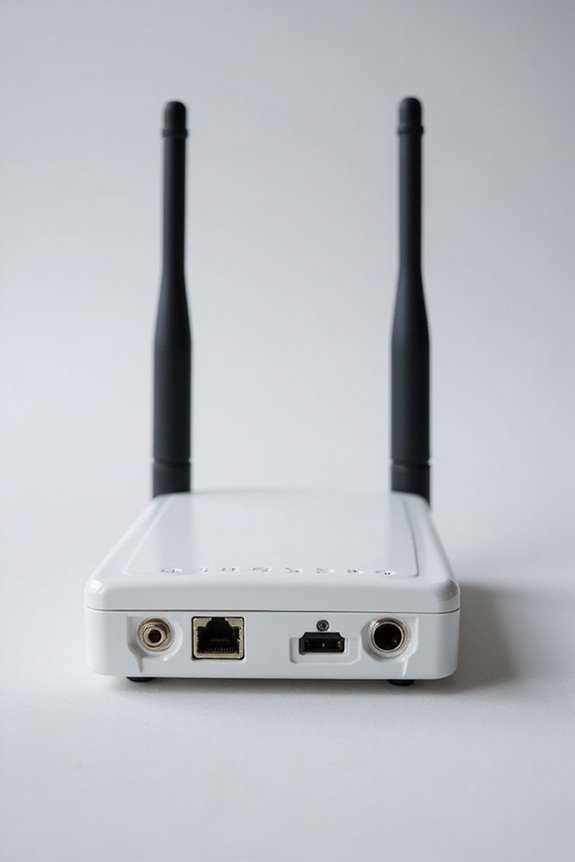
When picking a marine WiFi access point, you’ll want to think about a few key factors. What’s your coverage area like—are you in a cozy cove or out on the open ocean? Plus, consider connectivity options, speed, security features, and how adaptable the power supply is, because you definitely don’t want spotty internet ruining your fishing trip!
Coverage Area Considerations
Choosing the right marine WiFi access point revolves considerably around understanding coverage area—about 2,000 to 3,000 square feet is common for many models. Think about how many devices will connect; if you’re on a busy boat, you’ll need one that supports multiple users without slowing down. Also, consider dual-band access points; these operate on both 2.4 GHz and 5 GHz, offering better coverage and reducing interference, which is a win-win! Keep in mind the antenna configuration too; options with multiple antennas or beamforming tech can enhance your signal strength, especially out on the open water. Finally, don’t forget about environmental factors—obstacles like masts or even weather can play a big role in your connection’s effectiveness.
Connectivity Options Available
Finding the right connectivity options for your marine WiFi access point is essential for getting the most out of your onboard internet experience. First, think about the number of Ethernet ports. After all, you don’t want to argue over who gets to connect first! Also, Power over Ethernet (PoE) helps cut down on cable clutter, making installation a breeze. Next, dual-band capabilities give you better speed; who wants buffering at sea, right? Consider the maximum client capacity too; the more devices, the better! Finally, check for mesh networking compatibility—this guarantees strong, seamless coverage on larger vessels. With the right options, you’ll be surfing the web like a pro while enjoying the waves!
Speed and Performance Metrics
Speed and performance metrics can make a world of difference when you’re out on the water, and choosing the right marine WiFi access point can feel a bit like steering through choppy seas. You’ll want to pay attention to Mbps—higher numbers like 7.8 Gbps in tri-band systems can handle multiple devices effortlessly. If you have Wi-Fi 6, the aggregate speeds of up to 3 Gbps allow for smoother sailing through features like MU-MIMO. Coverage matters too—some access points span over 3,000 sq. ft., essential for larger vessels. Consider client capacity; some models support up to 456 devices, ideal for crowded environments. Finally, low latency means fewer delays, especially when you’re streaming or gaming—because who wants lag when steering the open sea?
Security Features Importance
When you’re out on the open water, securing your marine Wi-Fi network is just as important as steering those waves. You wouldn’t leave your boat unlatched, right? Look for security features like WPA3 encryption, which protects sensitive data from unauthorized access. Supporting multiple SSIDs allows you to separate networks for guests and crew, enhancing security—a smart move! Client isolation can further protect your devices by keeping them from communicating with each other. Don’t forget about VLANs, too; they help control data flow among different user groups, boosting security even more. And remember, regular firmware updates are a must! They patch vulnerabilities, so make sure your system stays secured tighter than your boat at a marina.
Power Supply Flexibility
Choosing the right power supply for your marine Wi-Fi access point is like picking the perfect anchor; it needs to hold strong in unpredictable conditions. Look for options like Power over Ethernet (PoE) compatibility, which simplifies installation since you won’t need separate outlets. Having access points that run on both AC power and PoE can give you flexibility, especially when power sources on boats are scarce. Make sure the device supports different voltage requirements to suit various marine setups. Also, keep an eye on the maximum power draw; you don’t want to fry your system. Finally, don’t forget about temperature tolerance—marine environments can get pretty extreme! This way, your Wi-Fi stays reliable, no matter the conditions.
Installation Ease Factors
Installing a marine Wi-Fi access point can feel like a puzzle, but with a few smart choices, you can make the process a whole lot easier. Start by looking for access points that come with all the mounting hardware—this saves you a trip to the hardware store! Also, consider models that support Power over Ethernet (PoE); it cuts down on messy cables and gives you more placement options. Check out app-based instructions, too; they can turn what might be a frustrating setup into a breeze. Opt for compact designs to fit into those tight spaces on your boat. Finally, take a peek at user reviews—real experiences can highlight any hiccups you might face. Happy surfing!
Frequently Asked Questions
How Can I Troubleshoot Connectivity Issues on My Marine Wifi Access Point?
Imagine you’re enjoying a sunny day on the water, but your WiFi suddenly drops. Frustrating, right? Start by rebooting your access point—it’s like giving it a wake-up call! Next, check for interference from nearby electronics; even your toaster can mess things up! If you’re still struggling, verify your connection settings and make sure you’re within range. Sometimes, a little patience and troubleshooting can turn a digital drought into a flowing stream of connectivity.
Are Marine Wifi Access Points Waterproof or Weather-Resistant?
Marine WiFi access points aren’t fully waterproof, but many are designed to be weather-resistant. This means they can handle those unexpected splashes or light rain. However, you should still guarantee their installation’s smart because a little extra protection always goes a long way. Think of it like wearing a raincoat; it shields you from the elements, but you wouldn’t want to go for a swim in it, right? Stay connected, but stay smart!
What Is the Typical Range of Marine Wifi Access Points?
So, what’s the typical range of marine WiFi access points? Generally, you can expect a range of about 1 to 3 miles, depending on the conditions and equipment. If you’re near land, you might find better connectivity, but head out to deeper waters, and things can get trickier. Remember, obstacles like buildings or other boats can interfere, so keep your antennas clear. Think of it as fishing—you’ve gotta cast your line wisely!
Do I Need a Separate Router for My Marine Wifi Access Point?
You might not need a separate router for your marine WiFi access point, but having one can definitely enhance your setup. Think of it as giving your signal a little turbo boost. If your access point doesn’t include routing features, you’re probably going to want one to manage multiple devices effectively. Plus, some routers offer advanced settings to optimize performance. So, a separate router could be a smart choice—unless you enjoy a game of connectivity hide and seek!
Can I Use a Marine Wifi Access Point on Land?
Imagine casting your net into a sea of connectivity, only to find it snagged on dry land! You can absolutely use a marine WiFi access point on land, but it might not be ideal. Designed for nautical conditions, it may struggle with interference from surrounding structures. Still, if you need a backup, go for it! Just remember, the ocean’s charm isn’t the same as your backyard BBQ, right? Keep your expectations grounded!


![EnGenius Wi-Fi 6 [EWS356-FIT] Dual Band AX3000 | Cloud & App & OnPrem Control Options | WPA3,...](https://m.media-amazon.com/images/I/11eSO8f6WTL.jpg)


